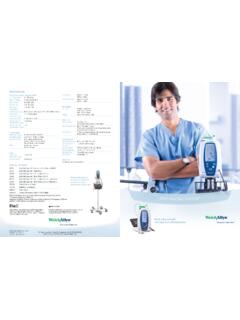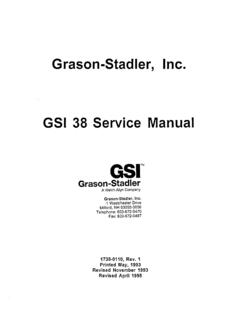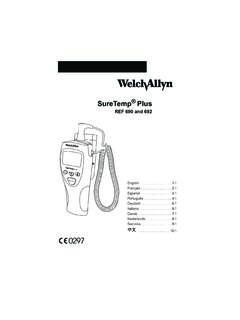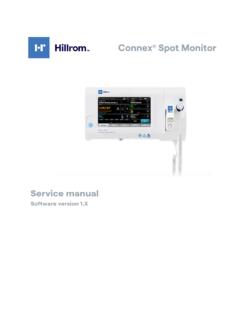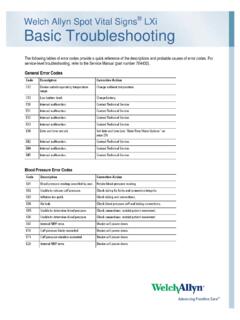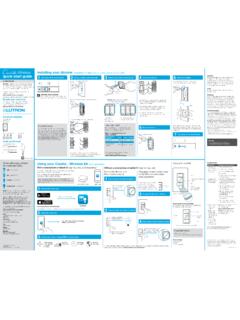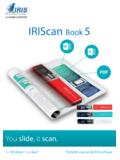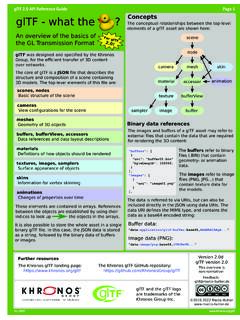Transcription of Spot Vision Screener-Quick Reference Guide - Hillrom
1 SpotTM Vision Screener quick Reference1 Charging the Vision screenerNote: The device needs to be charged for 4 hours before Connect the provided DC cord set and power supply/ charger Locate the DC power connector on the Vision screener and connect the power supply/charger. The DC power connector easily inserts into the Vision Using force to connect the power charger can damage the device and voids the Plug the DC power cord into an available wall outlet to charge the on the Vision screenerTo turn the Vision screener on, press and release the Power button located below the Welch Allyn logo. The start-up process takes approximately 30 seconds, then the device displays the Home , display window, and connections1. Ambient light sensor 7.
2 AC power connector2. LCD screen 8. Power button3. Neck strap mount 9. Wrist strap mount4. USB port10. Range finder5. Battery charge green LED indicator (Flashing) or charged (Continuous)11. Front glass12. Speaker6. Tripod mount1234563789101112 Device home screen1. Queue View, select or search for queued subjects from a list to begin the screening History View already screened subjects (completed records).3. Tools A variety of options to customize the Vision The Start button allows you to: Enter subject information such as ID, First and Last Name, Gender and Date of Birth (DOB)/Age (Required) Find queued subjects (exact match on the ID screen) Begin the screening process (Binocular and Monocular available) Review and print screening results5.
3 Battery status Battery Charging Battery charge status 6. Age Range To begin instant screening, with no personal subject data, select an age range of the subject from the Home screen. You can enter subject data after the screening if Vision Screener quick Reference2 The Subject Results screen appears at the end of the screening : Do not allow the device storage to become 100% full. For best results, when the device has accumulated 300 records, delete all records from the Vision screener. Verify you have successfully exported the records to a USB flash drive before you select Clear the resultsAll results viewing options are in the Tools menu under Results. The device displays a message indicating whether the results are in or out of range.
4 The message is intended to prompt the caregiver to assess whether the subject should be referred to an eye care specialist for further evaluation or simply be monitored at future that are out-of-range are indicated in Pupillary distance8. Pupil size indicator9. Right eye (OD), Left eye (OS)10. Complete refraction SE Spherical equivalent DS Sphere DC Cylinder Axis Axis5. Screening result6. Home7. Cylinder convention8. Alignment indicator9. Degree, horizontal, verticalHow to screen a subjectBefore screening1. Dim the lights, if Close blinds or curtains, if The subject s back should be positioned to the interfering light Avoid direct light into the subject s eyes from: Ambient light sources Exterior light Incandescent and halogen lightsNote: Florescent light is the best testing environment, if options are a subjectIf the Vision screener has a location specified, the name of the location is displayed on the top left of the screen in parentheses.
5 If there is no location specified, and you want a location included in the screening information, on the Home screen touch Tools, and then touch Location to specify the screening exams are saved automatically. 1. Turn on the Vision screener. The Home screen Have the subject close his or her eyes for 10 to 15 seconds to encourage Stand approximately 3 feet (1 meter) from the subject with one foot ahead of the other for Hold the Vision screener on an even plane with the subject s Touch the age range on the Home screen that matches the age of the screening begins immediately. The Vision screener emits the sound of chirping birds. This sound is intended to focus the subject s attention on the device. Touch the Loudspeaker icon to mute the Keep the Vision screener steady until the screening wheel appears, indicating the capture process is underway.
6 SpotTM Vision Screener quick Reference31. Touch Tools, and then touch Printer. The Available Printers screen Touch Plus. The Add Printer screen Select the printer to add, and then touch If you do not see the printer you want to add, touch To verify the printer is installed correctly, touch Print test more detailed information, see the device Direction for Accommodation is the automatic adjustment of the focus of the eye by flattening or thickening of the occurs when the subject fixates on the Vision screener. This improves Vision for hyperopia (farsighted) reduce the possibility for a subject to accommodate Once the subject is seated, have the subject close his or her eyes for 10 to 15 seconds to encourage dilation. Position the Vision screener on the same plane with the subject s eyes.
7 Activate the screening seconds before the subject opens his or her eyes. Ask the subject to open his or her eyes to obtain quick capture, prior to the subject s eyes readjusting to the lights. To encourage dilationThe Vision screener yields a Pupils too small message if the following occurs: The pupils are constricted below 4 mm. If the subject has something impeding the Vision screener s infrared light source, such as blindness in one eye, cataract, media opacity, attempt recommendation Once the subject is seated, have the subject close his or her eyes for 10-15 seconds to encourage dilation. Position the Vision screener on an even axis with the subject s eyes. Activate the screening seconds before the subject opens his or her eyes.
8 Ask the subject to open his or her eyes, which allows for a quick capture before the subject s eyes readjusts to the attempt recommendation In addition to the recommendations from the first attempt: Have the subject use his or her hands to shield his or her eyes, or Use a book or magazine to shield his or her network configurationIf the device is configured with your organization s wireless network settings, you can view screening results on a computer. If you want to print screening results, you can connect the device to a USB printer or you can add a wireless network printer. To view current network settings, touch Tools and then Network .Wireless networks use security to protect your information. Your organization s system administrator can supply you with the case-sensitive security information needed to access the you can connect the device to a network, you need the following.
9 FieldDescriptionRequirementsSSIDThe name of your wireless name can consist of letters, numbers, or a combination of both, up to 32 passphrase, or password, is used to protect the privacy of your wireless format of the passphrase or password depends on which security type you Security TypeNoneIf this option is selected, the connection to the wireless network is not encrypted, and any information sent or received on this network is not necessarily WEP passphrase must be either 5, 10, 13, or 26 PSKThe WPA/2 PSK passphrase must be between 8 and 64 EAP-PEAPThe WPA/2 EAP-PEAP username and the password must be between 1 and 64 connect to a wireless network1. Touch Tools, and then touch Network .2. To connect a device to the network, add the network name (SSID), security type, and passphrase or password.
10 3. Touch OK to save your changes and return to the previous have successfully connected the device to your wireless network. The vertical bars indicate the strength of the device is not connected to the network. For tips on connecting to the network, refer to more detailed information, see the device Directions for the Vision screener to a printerThe Vision screener is capable of connecting and printing to most network-capable Hewlett-Packard printers. The Vision screener also contains some generic PCL drivers that can be used with older printers. For more information, see the device Directions for can connect the Vision screener to a USB printer or, if the Vision screener is connected to a wireless network, to a wireless network Vision Screener quick Reference4 System freezeIf the Vision screener locks up and becomes unresponsive to the touch, perform a hard system reset.
